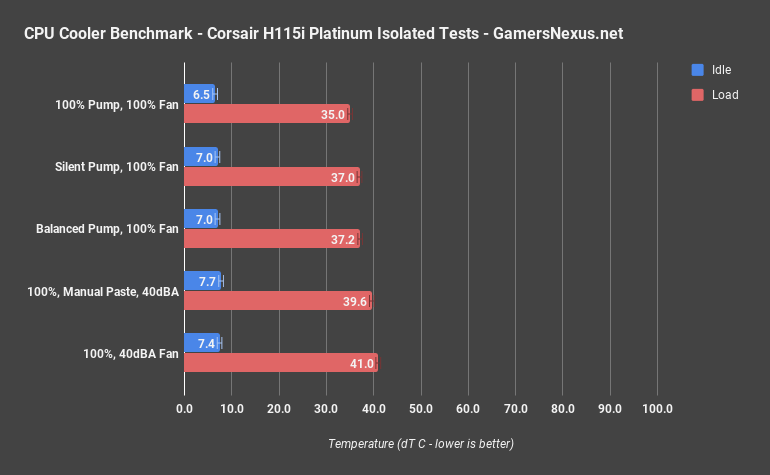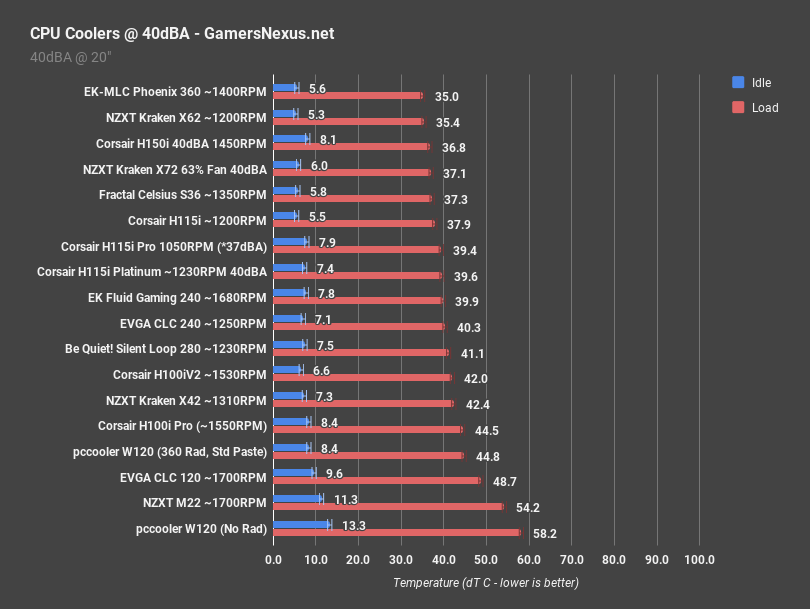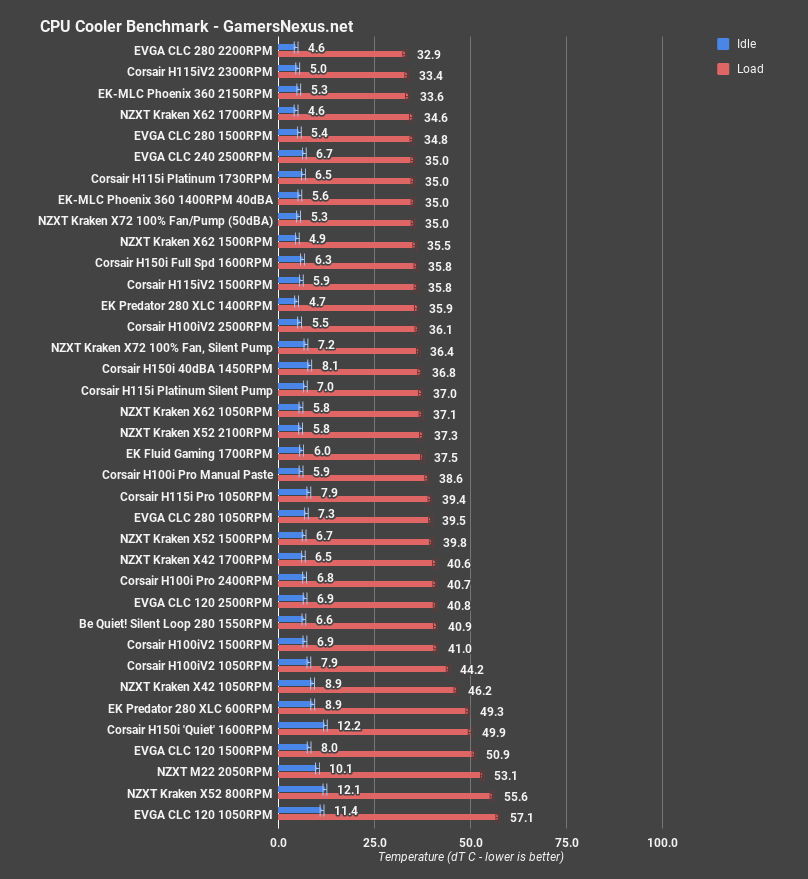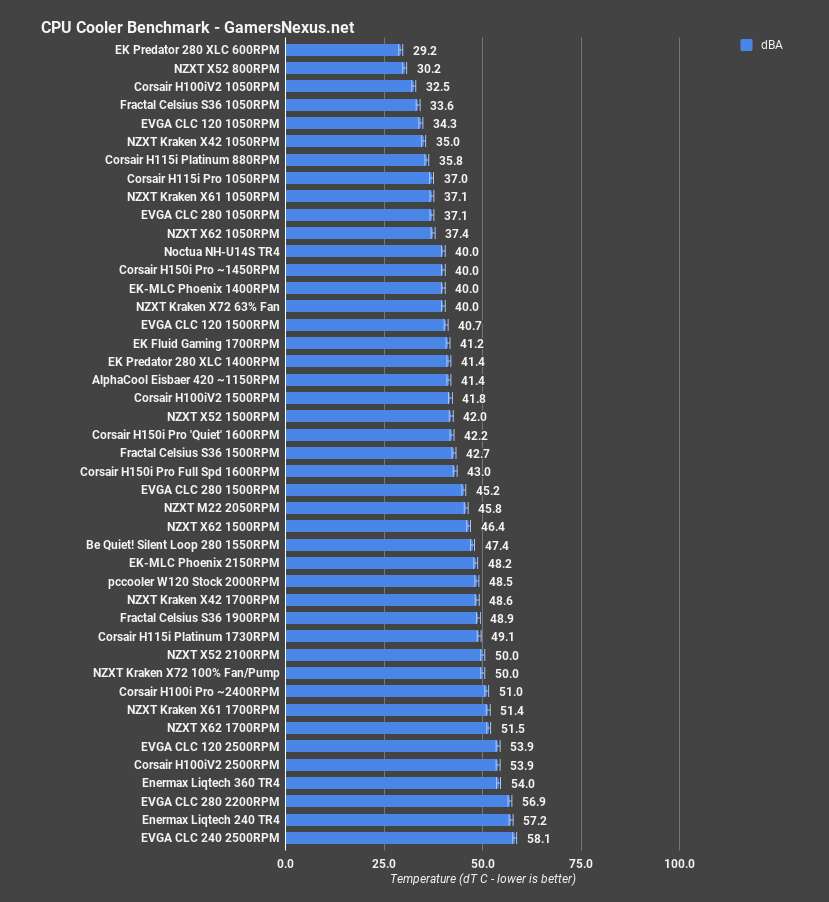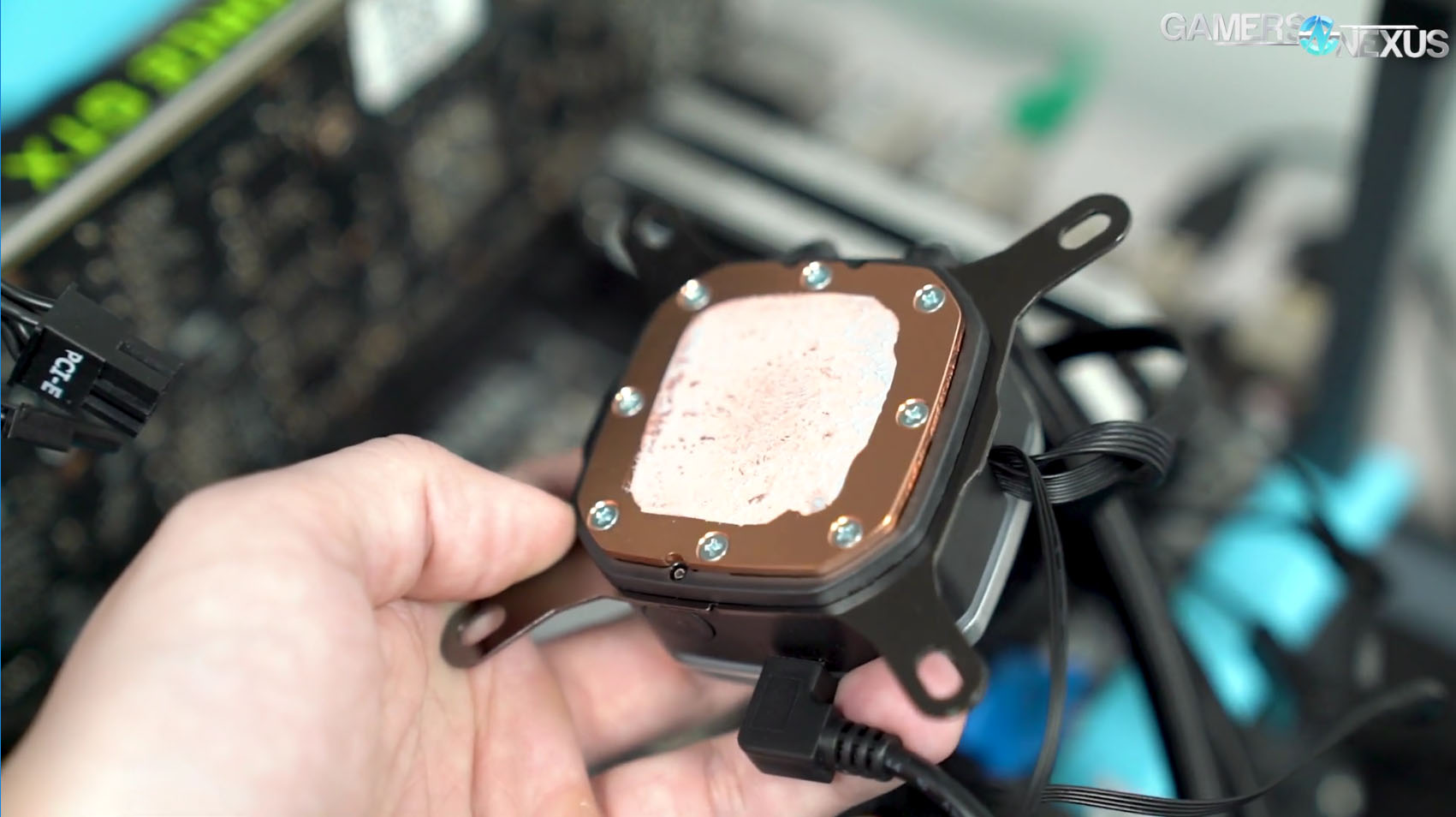Asetek has a stranglehold on most of the closed-loop liquid cooler market for PC hardware, easily holding majority placement in all CLCs sold in the US. CoolIT has long been a contender of Asetek’s, with the two having battled legally over Asetek’s patents on pump-in-block design, and has also been one of Corsair’s two liquid cooling partners. Both Asetek and CoolIT make the Corsair liquid coolers, though the latter fell out of popularity for a number of years. Finally, with the Platinum line, Corsair is working with CoolIT in a mainstream product. The H115i Platinum uses a new pump and block design, and that’s something we’ll show off thoroughly in our upcoming liquid cooler internals comparison video. For today, we’re focusing on reviewing the $160 H115i Platinum for thermals, acoustics, and overall value at the price point.
Asetek has previously received settlements in legal disputes against CoolIT, the other supplier of Corsair’s closed-loop liquid coolers, and has also won legal battles against Cooler Master for its Seidon series. Asetek, it seems, has a patent on the pump-in-block design approach, and has had judges rule in its favor. This has led to an exodus of non-Asetek coolers in the US market, with companies like Swiftech and Be Quiet! pulling their similarly-made (but non-Asetek) coolers out of the US market. We’re left with a few braver souls, like those using Apaltek-made designs, and some companies that have worked around the patents. DeepCool would be an example, which uses a three-chamber, very complicated approach to its pump manufacturing.
As a reminder, Corsair has multiple models of “H115” coolers. The H115i, the original, is an older Asetek design. The newer H115i Pro uses the Asetek Gen6 pump. The H115i Platinum uses CoolIT’s solution.
As a recap of each, the Gen4, Gen4.5, and Gen5 Asetek solutions are widely used in the industry. You can find Gen4.5 pumps in the EVGA Hybrid CLC, Gen5 pumps in the NZXT Kraken series, and Gen4 pumps just about everywhere. Generation 4.5 runs a much higher pump RPM (and higher noise), and is therefore more performance-oriented at the loss of acoustic performance. Generation 5 pumps opened up design opportunities to NZXT to build its own custom RGB LED PCB, something that Asetek hadn’t previously allowed. Generation 6 pumps don’t improve performance – and are technically marginally worse than Gen5 – but instead focus on reducing the rate of permeation of liquid into the tubes and housing. Gen6 focused on eliminating hotspots in the loop to slow the rate of permeation and also added a more advanced impeller, moving away from the three-pronged yellow impellers of Asetek’s past. You can find our previous coverage of the internal pump differences in Asetek generations here.
We need to disassemble the H115i Platinum still and will run a separate video for that content, but that’ll reveal CoolIT’s internal design.
As for Corsair’s naming, it’s certainly becoming confusing. The company is too attached to one series name. There have even been “V2” appearances in Corsair’s models before, indicating a radiator change pursuant to an intellectual property concern, apparently.
CPU Cooler Test Methodology
CPU cooler testing is conducted using the bench defined below. We use a bench that is more carefully crafted for noise performance, opting for a passively cooled PSU and 23% RPM 980 Ti blower fan for very low system noise.
We strongly believe that our thermal testing methodology is among the best on this side of the tech-media industry. We've validated our testing methodology with thermal chambers and have proven near-perfect accuracy of results.
Conducting thermal tests requires careful measurement of temperatures in the surrounding environment. We control for ambient by constantly measuring temperatures with K-Type thermocouples and infrared readers. Two K-Type thermocouples are deployed around the test bench: One (T1) above the bench, out of airflow channels, and one (T2) approximately 2-3" in front of the cooler's intake fan. These two data points are averaged in a spreadsheet, creating a T3 value that is subtracted second-to-second from our AIDA64 logging of the CPU cores.
All six CPU cores are totaled and averaged second-to-second. The delta value is created by subtracting corresponding ambient readings (T3) from the average CPU core temperature. We then produce charts using a Delta T(emperature) over Ambient value. AIDA64 is used for logging thermals of silicon components, including the CPU and GPU diodes. We additionally log core utilization and frequencies to ensure all components are firing as expected. Voltage levels are measured in addition to fan speeds, frequencies, and thermals.
The cores are kept locked to 3.8GHz (x38 multiplier). VCore voltage is locked to 1.141v for the CPU. C-States are disabled, as is all other power saving. The frequency is locked without any interference from boost or throttle functions. This is to ensure that the CPU does not undergo any unexpected/uncontrollable power saving or boost states during testing, and ensures that the test platform remains identical from one device to the next.
Fan speeds are manually controlled unless otherwise defined. For liquid coolers, pumps are set to 100% speed unless otherwise defined.
No open bench fans are used for these CPU cooler tests. Only fans which are provided with the cooler are used.
| GN Test Bench 2015 | Name | Courtesy Of | Cost |
| Video Card | GTX 980 Ti Reference 23% RPM | NVIDIA | EOL |
| CPU | Intel i7-5930K CPU @ 3.8GHz | iBUYPOWER | $580 |
| Memory | Corsair Vengeance 32GB 2666MHz | Corsair | $175 |
| Motherboard | EVGA X99 Classified | GamersNexus | $365 |
| Power Supply | Enermax DigiFANLESS | Enermax | $250 |
| SSD | HyperX Savage SSD | Kingston Tech. | $130 |
| Case | Top Deck Tech Station | GamersNexus | $250 |
| CPU Cooler | This is what we're testing! | - | - |
We use an AMPROBE multi-diode thermocouple reader to log ambient actively. This ambient measurement is used to monitor fluctuations and is subtracted from absolute GPU diode readings to produce a delta value. For these tests, we configured the thermocouple reader's logging interval to 1s, matching the logging interval of GPU-Z and AIDA64. Data is calculated using a custom, in-house spreadsheet and software solution.
Our test starts with a 180s idle period to gauge non-gaming performance. A script automatically triggers the beginning of a CPU-intensive benchmark running Prime95 LFFTs. Because we use an in-house script, we are able to perfectly execute and align our tests between passes.
Results
Let’s start testing with just the H115i Platinum on the charts, then we’ll add a bunch of competitive analysis with other coolers.
For just the H115i Platinum, we changed pump speeds and fan speeds to benchmark performance. Stock, with full pump and fan speed, we measured performance as hitting 35 degrees Celsius over ambient on our standardized test bed. Idle was about 6.5 degrees over ambient. Setting the pump speed to “Balanced” and leaving fan speed to full, we saw an increase of 2 degrees Celsius in load temperatures. Because “balanced” is dependent upon liquid temperature, “silent” ends up with the same results. We’d really have to strain balanced harder in order to show differences; in theory, it should prove more useful when bouncing between idle loads and heavy loads more rapidly, and should show further use when in thermally constrained cases. For our test bench, balanced ran at about the same 2000-2400RPM range as silent.
Set to a noise-normalized 40dBA, performance climbed to 41 degrees over ambient, for an increase of about 6 degrees over stock. We next tested with a repaste using our standard Asetek compound, finding almost zero change between the two results – we’re within a +/-1 margin of error, at 39.6 degrees versus 41 degrees.
The more important thing here is that the stock CoolIT compound spread is actually sufficient to cover the X99 CPU. This isn’t true on most of the pre-applied pastes of Asetek coolers, where they primarily cover LGA115X CPUs, but don’t get full coverage on HEDT CPUs. This fuller spread is one of the improvements in the new cooler, and is something that CoolIT did well to fix. It’s not a big change from what Asetek does, but it’s a small one and one which is noticeable.
40dBA
This next test is noise-normalized for 40dBA, where each cooler has a noise budget up to 40dBA at 20” distance in a room with a noise floor of 26dB. This allows us to see which cooler has the most efficient performance. The trouble with maximum speed benchmarks is that they aren’t really comparable, as some fans might run at 2x the speed of others and produce more noise in the process. This test fixes the noise level to 40dBA, so we are controlling for noise to get a comparable thermal result.
At 40dBA and with our controlled paste applied, the H115i Platinum ends up at 39.6 degrees over ambient, which has it functionally tied with the EK Fluid Gaming 240 and other Corsair H115i models. Note that the Pro capped-out at 37dBA due to fan speed limitations, so it is slightly better here but more limited in maximum performance potential. The Fluid Gaming is a budget-class open loop and has much more water present, as it has a standalone reservoir and separate pump, and so doesn’t really count as a fair comparison. The H115i Platinum is within reasonable margin of error of the other H115 models and those slightly warmer than it; given the variables involved in testing, we are at limits of test resolution. The H115i Platinum does prove better than the H100iV2, to no surprise, and better than the Be Quiet! Silent Loop 280, or close to error margins, anyway. The 360mm coolers, like NZXT’s Kraken X72 and Corsair’s own H150i, outperform the H115i Platinum by way of having more fans and a larger radiator. The cost difference is also present, so while normalized at 40dBA and with the stock fans to keep costs controlled, the H115i Platinum ends up about 2-3 degrees warmer than the H150i at 40dBA. For most people, the 280mm CLC performs well enough and that 2-degree difference may never be noticeable.
Competitive Chart
For the fuller chart now, the H115i Platinum at maximum pump and fan RPM puts it at 35 degrees Celsius over ambient, which has it as functionally tied with the EVGA CLC 240 at its maximum RPM of 2500. This difference is the result of EVGA’s aggressive fans, which hit 58.1dBA to Corsair’s 49.1dBA on the Platinum at max speed. The two achieve the same thermal result, but Corsair’s achievement is done at a much lower noise level. Its $160 price is also more expensive than EVGA’s $100 CLC 240, but the extra radiator and fan size does benefit its noise levels significantly. More fairly compared, the H115i Platinum also competes closely with NZXT’s Kraken X62, which has performance within our error margins. It’s also near the H150i’s 35.5-degree result, equipped with slower fans, and not distant from the original H115iV2 at 1500RPM, ranking 35.8 degrees Celsius over ambient.
Noise
For noise levels at 20” distance, the H115i Platinum ends up at 49.1dBA when at 1730RPM, 40dBA when at 1200RPM, and about 35.8dBA when at 50% speed, or about 900RPM. Comparatively, the NZXT Kraken X62 peaks at about 51.5dBA when at 1700RPM. Corsair falls within the expected noise range for a cooler with this fan RPM.
Conclusion
The Corsair H115i Pro is more limited in top-end performance than the H115i Platinum, but it’s entirely because of the fans used. The H115i Platinum is “better” at max speeds as a result of higher RPM fans, but realistically, thermals aren’t really all that different. This review boils down to a few simple things:
If you’re buying for thermal performance and don’t care at all about looks, just save the money and go for something like an EVGA CLC 280. The pricing is favorable in this trade. If you’re looking for RGB LEDs, well, the H115i Platinum does that well, and we’ll give Corsair credit for overhauling the illumination on the H115i Platinum.
We developed a small list of grievances while working on the H115i Platinum. None of these items are deal-breakers, but they are things that Corsair could improve upon for future iterations – and, given Corsair’s love of the “H115” name, we suspect there will be more. For one, we noticed that the radiator bracket isn’t spaced far enough away from the radiator core itself, and the included screws (even with a washer or two) will pierce the fins behind the radiator bracket when fully screwed in. This isn’t a big deal – as long as Corsair doesn’t have a water tube behind the screw hole, it’s not going to hurt anything in a meaningful way. Corsair did run its water lines away from the screws, so we’re good there, but we’d still like to see another 0.5mm of spacing between the screw hole and the radiator fins, or maybe just a simple pad to catch the screw. Our second complaint is about the cable design, which results in an octopus that becomes difficult to manage. The pump tachometer and SATA power are all bundled into one wire, and the user is expected to pull them apart if requiring a different cable pathway for the tachometer. This is sub-optimal and results in awkward wiring. The two fan cables, power cable, tachometer, and two RGB LED cables, plus two cables per fan (four total) can quickly result in a mess internally.
We also had the iCUE software drop communication with the H115i Platinum a few times, but it could always be fixed with a reboot or by resecuring the cable.
For what it’s worth, Corsair also just had a recall of the white version of its H115i Platinum RGB SE, but this issue should have been isolated and now fully resolved. We wouldn’t let this affect purchasing decisions for the non-SE model, as the details of the leak don’t affect the black edition of the cooler.
Overall, the cooler is fine. It’s not ground-breaking or revolutionary, but Corsair has done well on the RGB LEDs. People who are buying for easy LEDs should consider the NZXT Kraken X62 and Corsair H115i Platinum. Those buying for performance should ignore both, as they’re priced for their LEDs, and instead buy something more barebones (like the EVGA CLC 280).
Editorial, Testing: Steve Burke
Video: Josh Svoboda, Andrew Coleman
